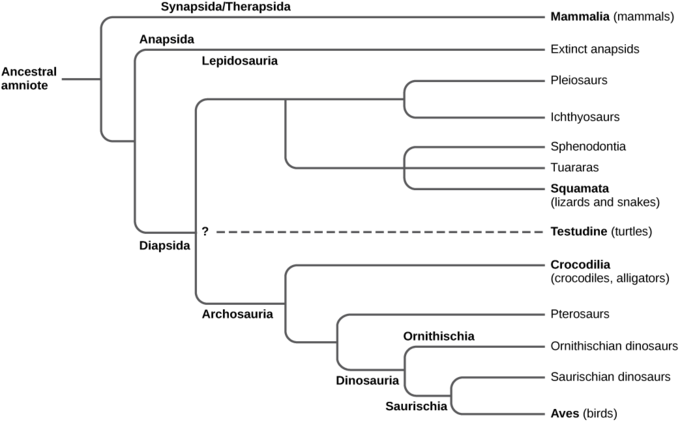29.3C: Evolution of Amniotes
- Page ID
- 13928
Modern amniotes, which includes mammals, reptiles, and birds, evolved from an amphibian ancestor approximately 340 million years ago.
- Outline the evolution of amniotes
Key Points
- Synapsids include all mammals and therapsids, mammal-like reptiles, from which mammals evolved.
- Sauropsids, which are divided into the anapsids and diapsids, include reptiles and birds.
- The diapsids are divided into lepidosaurs (modern lizards, snakes, and tuataras) and archosaurs (modern crocodiles and alligators, pterosaurs, and dinosaurs).
- Skull structure and number of temporal fenestrae are the key differences between the synapsids, anapsids, and diapsids; anapsids have no temporal fenestrae, synapsids have one, and diapsids have two.
- Turtle classification is still unclear, but based on molecular evidence, they are sometimes classified under diapsids.
- Although birds are considered distinct from reptiles, they evolved from a group of dinosaurs, so considering them separately from reptiles is not phylogenetically accurate.
Key Terms
- synapsid: animals that have one opening low in the skull roof behind each eye; includes all living and extinct mammals and therapsids
- anapsid: amniote whose skull does not have openings near the temples; includes extinct organisms
- diapsid: any of very many reptiles and birds that have a pair of openings in the skull behind each eye
- temporal fenestrae: post-orbital openings in the skull of some amniotes that allow muscles to expand and lengthen
Evolution of Amniotes
The first amniotes evolved from their amphibian ancestors approximately 340 million years ago during the Carboniferous period. The early amniotes diverged into two main lines soon after the first amniotes arose. The initial split was into synapsids and sauropsids. Synapsids include all mammals, including extinct mammalian species. Synapsids also include therapsids, which were mammal-like reptiles from which mammals evolved. Sauropsids include reptiles and birds and can be further divided into anapsids and diapsids. The key differences between the synapsids, anapsids, and diapsids are the structures of the skull and the number of temporal fenestrae behind each eye. Temporal fenestrae are post-orbital openings in the skull that allow muscles to expand and lengthen. Anapsids have no temporal fenestrae, synapsids have one, and diapsids have two. Anapsids include extinct organisms and may, based on anatomy, include turtles (Testudines), which have an anapsid-like skull with one opening. However, this is still controversial, and turtles are sometimes classified as diapsids based on molecular evidence. The diapsids include birds and all other living and extinct reptiles.

The diapsids diverged into two groups, the Archosauromorpha (“ancient lizard form”) and the Lepidosauromorpha (“scaly lizard form”) during the Mesozoic period. The lepidosaurs include modern lizards, snakes, and tuataras. The archosaurs include modern crocodiles and alligators, and the extinct pterosaurs (“winged lizard”) and dinosaurs (“terrible lizard”). Clade Dinosauria includes birds, which evolved from a branch of dinosaurs.

In the past, the most common division of amniotes has been into the classes Mammalia, Reptilia, and Aves. Birds are descended, however, from dinosaurs, so this classical scheme results in groups that are not true clades. Birds are considered as a group distinct from reptiles with the understanding that this does not completely reflect phylogenetic history and relationships.


